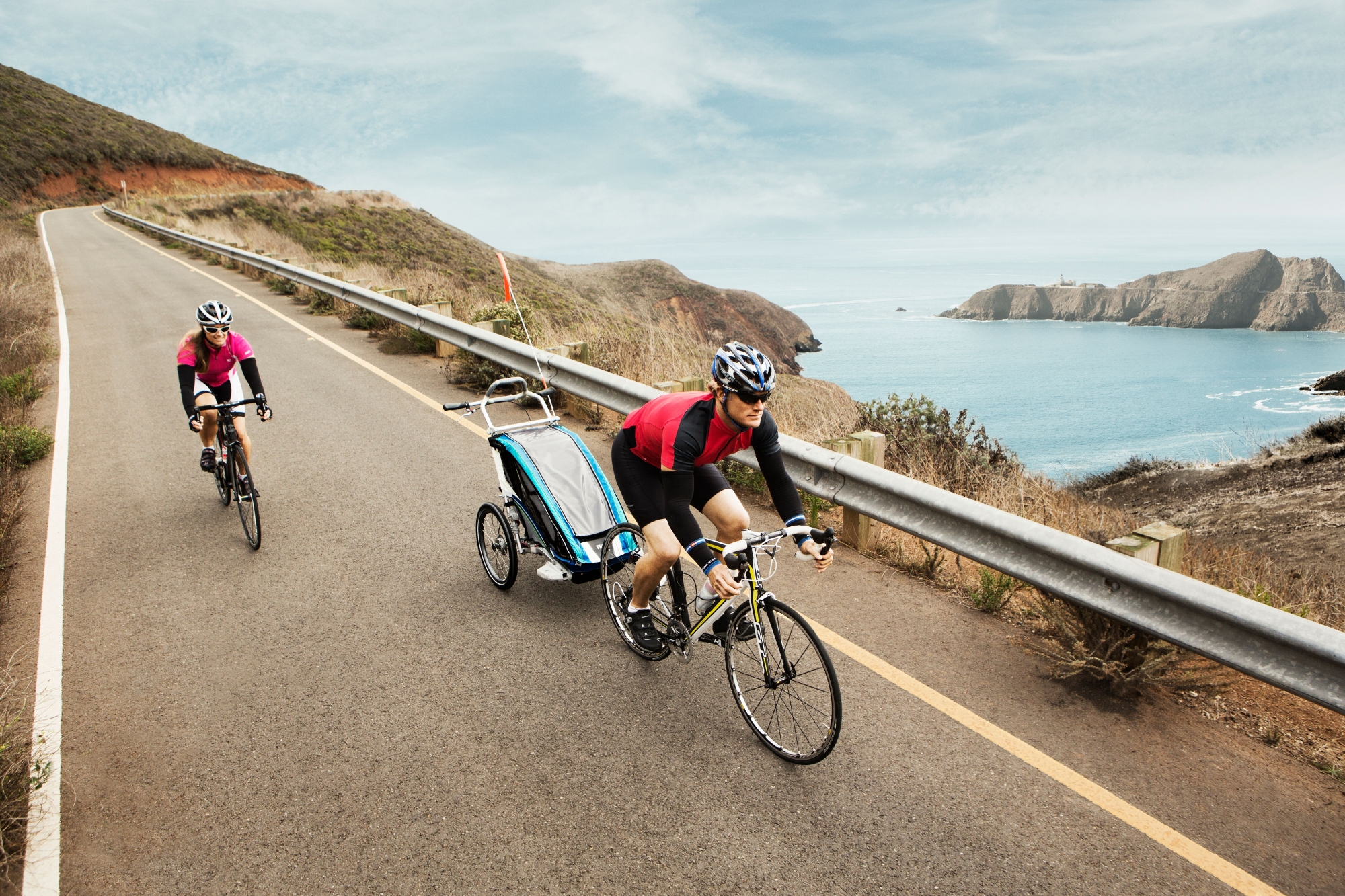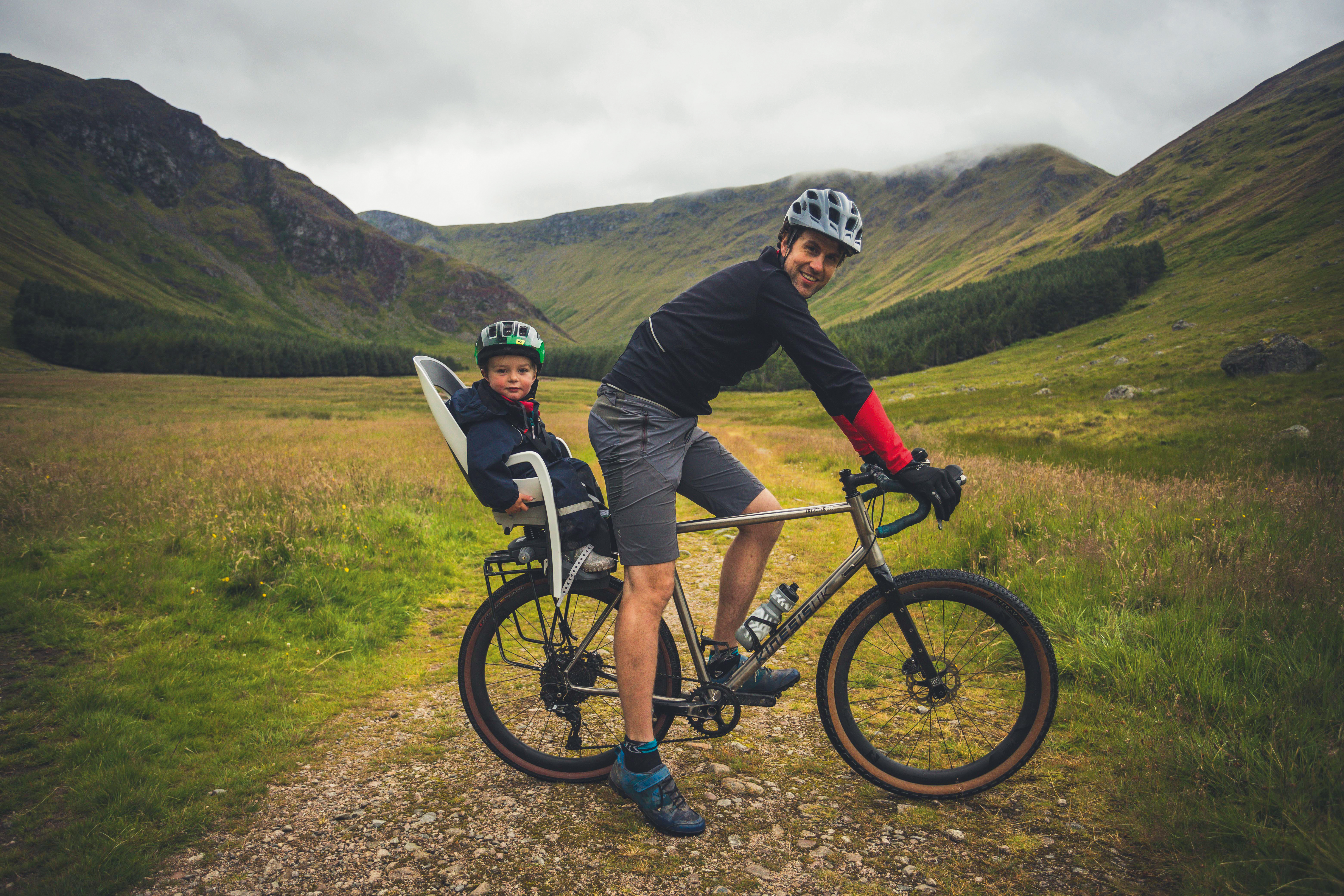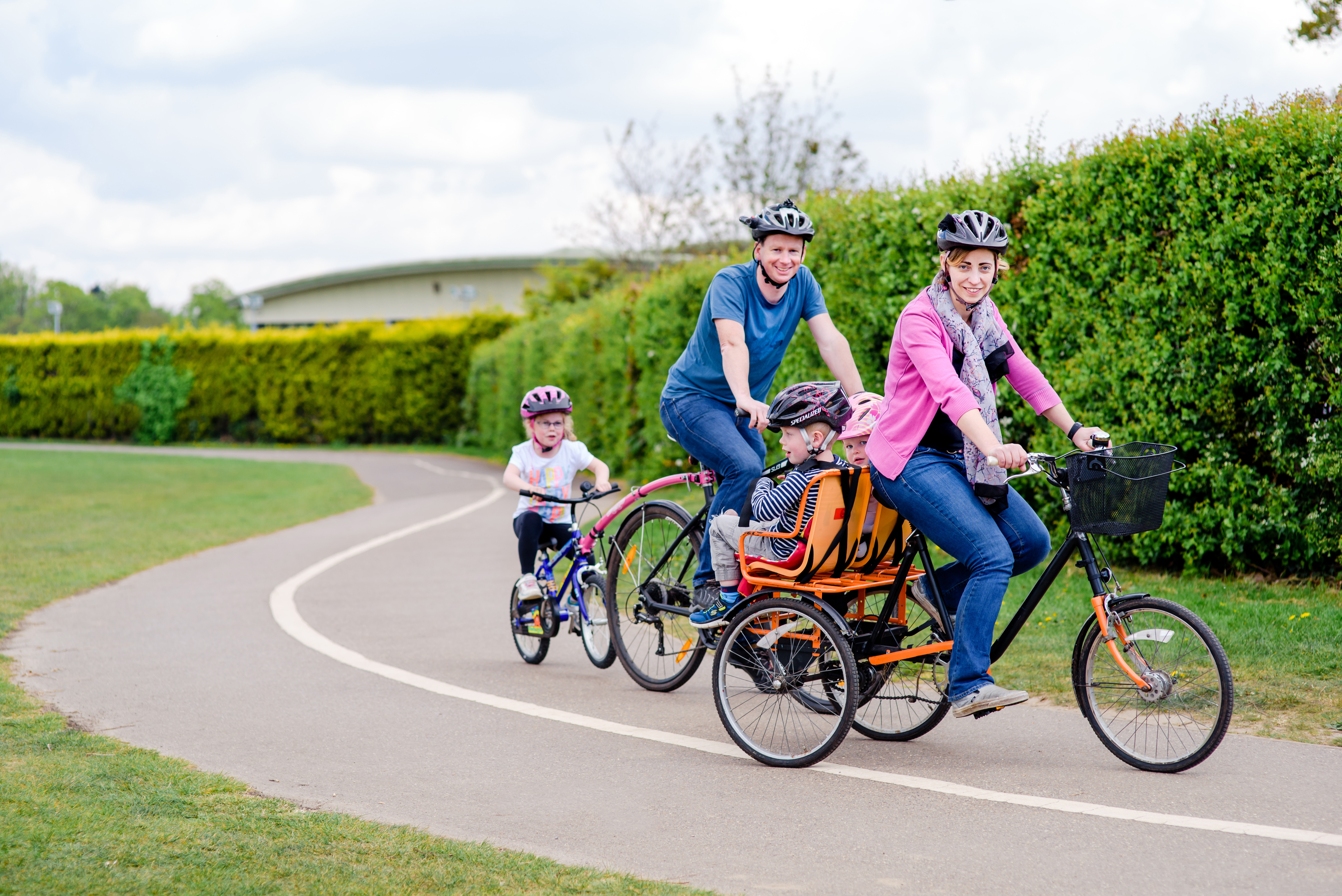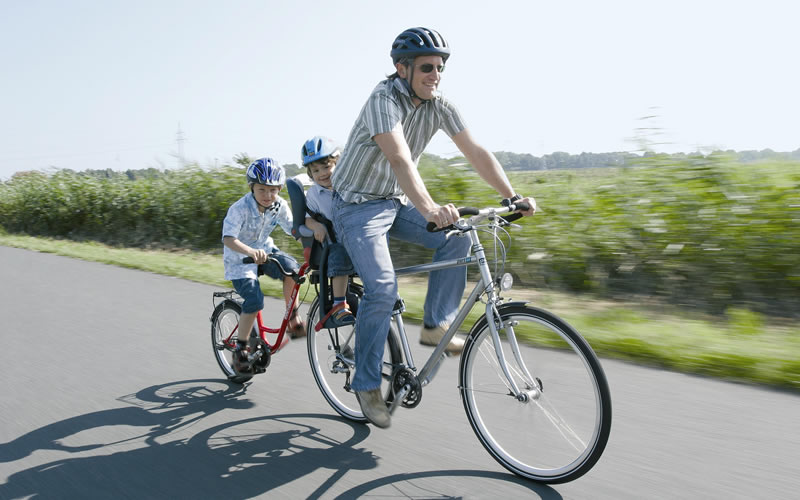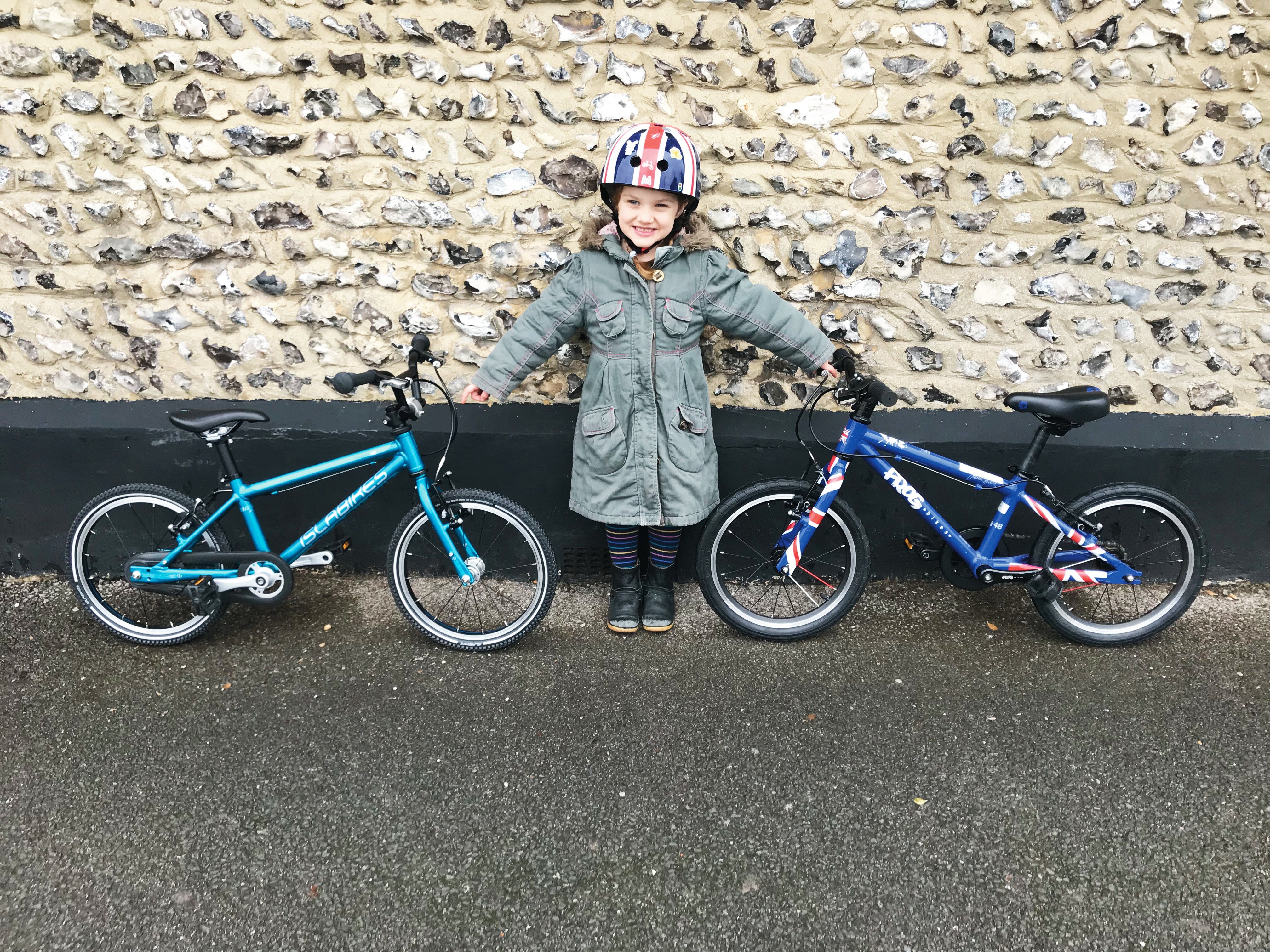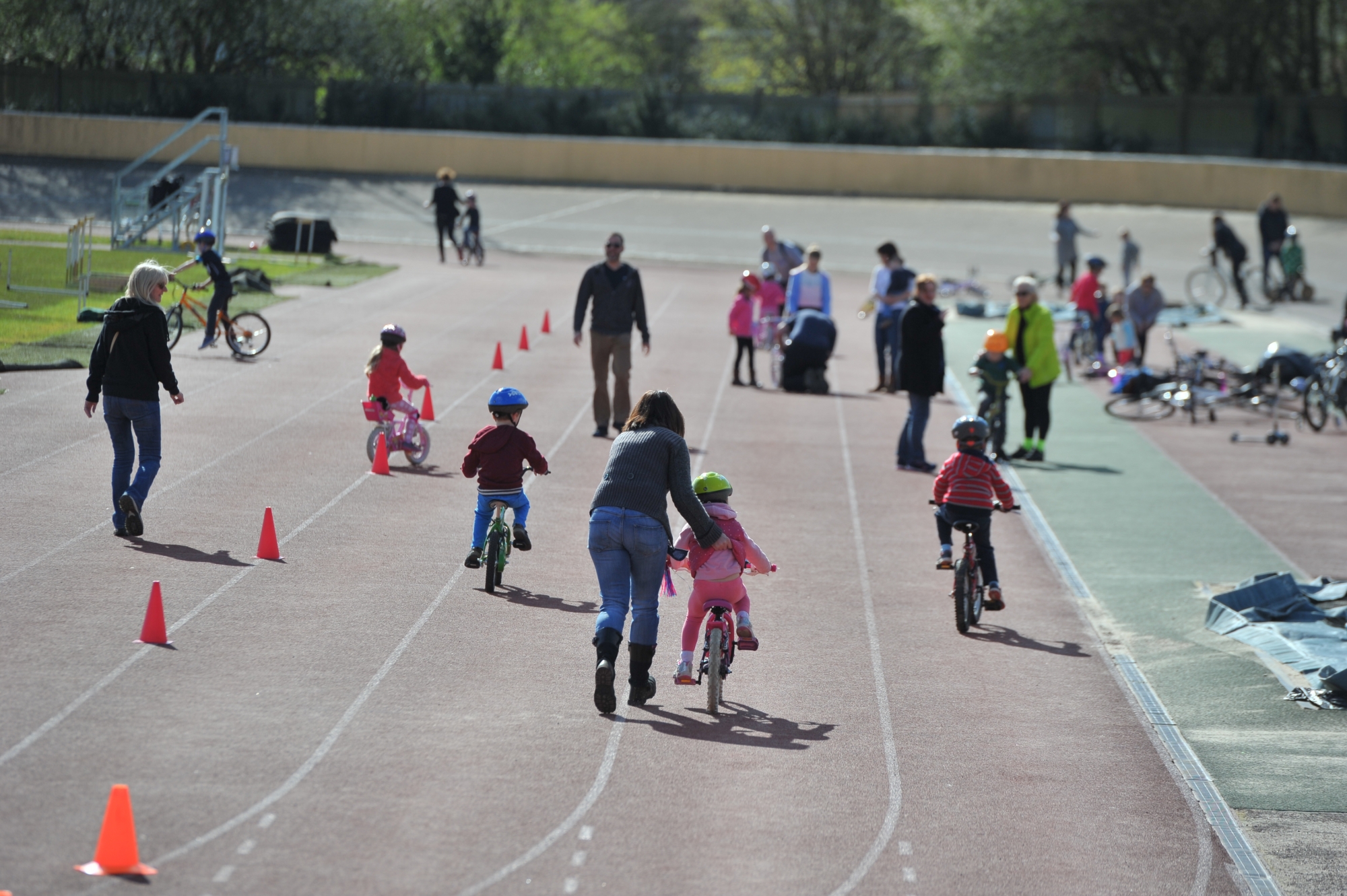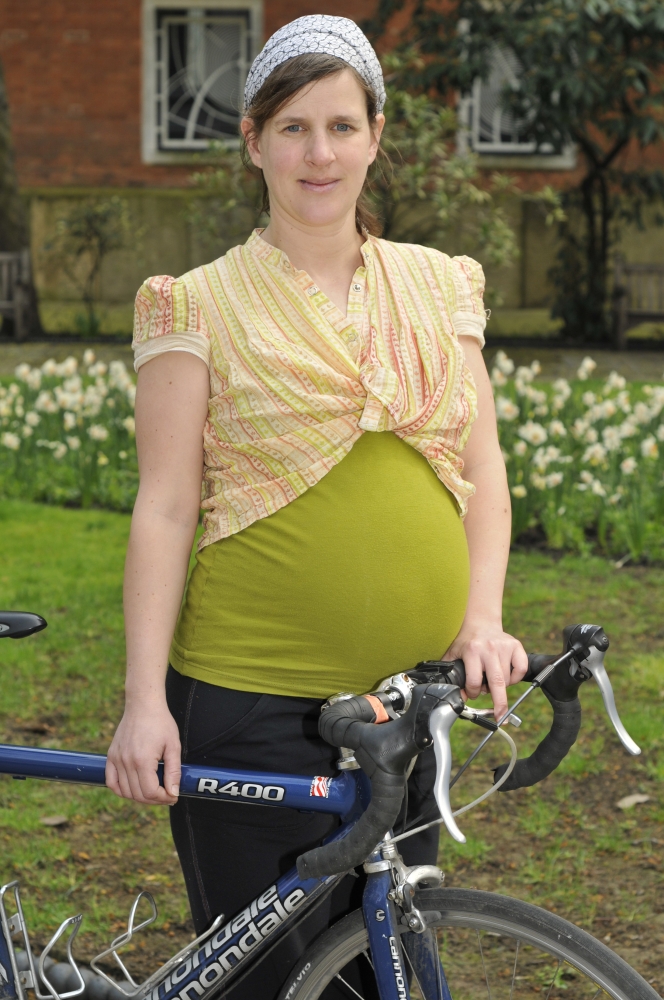Guide to child bike seats
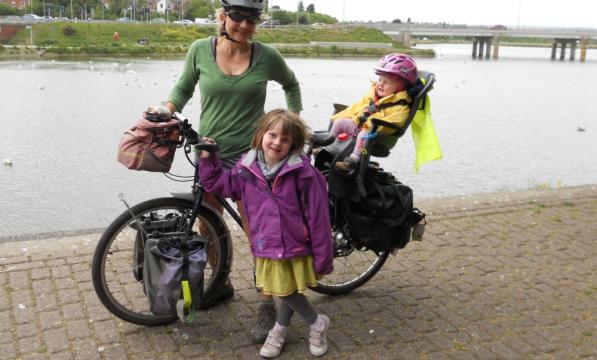
Most child seats are suitable for children between the ages of about nine months and four years. The lower limit is dependent on the ability of your child to sit up unsupported – that is, on the floor rather than propped up with cushions.
Some seats recline and children as young as six months – those who can sit up when propped up – can go in those. A reclining seat is better anyway because it allows your little one to drift off to sleep without slumping sideways or forwards.
The upper limit is restricted by weight rather than age. Seats are typically rated for passengers weighing up to around 20kg (44lb).
Even if a seat seems sturdy enough to take a heavier child than that, it’s a bad idea to exceed its weight limit. It’s not so much that the seat will break – although it might – rather that the handling of the bike gets progressively worse with a heavier passenger, particularly with a rear-fitting seat.
How many children?
It’s possible to use front and rear seats on the same bike, but unless you live somewhere flat, doing so makes the bike very cumbersome. A child trailer is a superior solution for two children.
If you need just the one seat, then, despite its handling quirks, the pedalling and safety advantages of a rear seat make it the better option.
Rear-fitting seats
Rear seats come in three basic designs: cantilevered from the seat tube; fixed to a rear carrier rack; and fixed directly to the seat tube and seat stays. Those that bolt to the frame – or to a rack that’s bolted to the frame – are more stable and sturdy but cannot be fitted to bikes with rear suspension. Bobike, Hamax and Thule all manufacture seats with various fittings.
Cantilevered seats use a big plastic bracket with two holes in it bolted to the seat tube. Into this slots a two-pronged rack that supports the seat. There’s some give in the rack, which offers a degree of springy suspension. This may not flex enough under smaller children, leaving them tipped slightly forwards.
Larger children and/or long-term use may flex it too far, bending it down towards the rear tyre or mudguard. Typically the more you pay, the sturdier the seat will be. The Hamax Sleepy and the Hamax Siesta are two of the better examples. They have a decent attachment bracket and the seat can be reclined.
Seats that fix to a rear carrier rack slide and lock onto the rack’s top, with a safety strap around the seatpost or seat tube for added security. With the child seat off, the rack can be used to carry panniers.
The Thule Yepp Maxi clips in to an EasyFit Adapter (sold separately) and has a soft, shock-absorbing seat that has an adjustable five-point harness and childproof safety buckle that secures them quickly and easily. Safety features also include an inbuilt reflector and the ability to attach a safety light. The Yepp Maxi has been designed and tested for children from nine months to six years old, up to 48.5lbs/22kg
Seats that fix directly to the seat stays and seat tube have long legs, some of which bolt to the seat stays, often using a quick release, plus a bracket that fits on the seat tube to prevent fore and aft movement.
Dutch company Bobike’s Exclusive Maxi is a good one. It’s well made, with a maximum load of 22kg. That should be enough for a six-year-old child, assuming you can still balance the bike properly.
Bobike offers a range of rear seats, some of which have either a frame mount to attach to the seat tube or a click-and-go mounting system to attach to a pannier rack.
Most seats fit best on medium- or larger-sized bikes with a conventional top tube. Small frames and those with a dropped top tube can cause fitting difficulties for any seat that uses a seat tube bracket.
Open frames – that is, frames without a top tube – can flex and shimmy alarmingly when you’re cycling with a heavier child on a rear seat, because the structure isn’t stiff enough. Look for fatter frame tubes and/or reinforcing tubes if you want to fit this kind of bike with a child seat.
Front-fitting seats
Front seats usually attach to the top tube, a bar fixed above it, or a bracket on the head tube. Some are moulded plastic seats, like smaller versions of rear seats, while others – aimed at older children who can hold on themselves – are just little saddles and footrests bolted to the bike.
Pros
- Front seats have the advantage that your child can see more
- You can talk to your child more easily
- You can explain traffic and what's up ahead easily
- You can have two seats on one bike
- Balance is actually better, particularly over bumps
- It’s a bit easier to get on and off the bike
- Your child won’t be able to pull on the back of your clothes or hair.
Cons
- In the event of a fall, or if you brake suddenly, you may move forward towards your child
- You may end up pedalling awkwardly with your knees out, but balance is actually better, particularly over bumps
- Your child is slightly more exposed to wind chill
- Those little saddles that bolt to the top tube aren’t recommended for anything other than short journeys. A tired child could slip sideways or let a foot dangle into the front wheel.
If you do want a front-fitting seat, Bobike makes ones suitable for one-two year olds that can be fitted with a windscreen. This greatly helps to protect against wind chill and rain.
For children aged up to four or so, the WeeRide Safe Front Seat is a better choice because it’s centre mounted on a bar above your top tube so designed for a heavier passenger.
Whether you choose a front or rear seat is a personal preference, Chris Juden, who was a senior technical officer and engineer for Cycling UK, explains his personal view in his blog on front child seats.
Fitting with a child seat on your bike
Even if you’re used to riding with rear panniers, a child seat takes some getting used to. Panniers put the weight around or between the axles. Child seats put the weight above and – more significantly – behind the rear axle, which destabilises the bike.
Get a plumb line to check where the base of the seat is relative to the rear axle. The shorter the distance it is behind the axle, the better the handling will be. If it’s level or in front, so much the better. There’s no hard and fast maximum distance, but keeping it under 10cm is a reasonable rule of thumb.
Before you ride with your child on the seat try loading it up with a heavy weight, such as a 7-10kg sack of potatoes, and take it for a ride. That will give you a clear idea of how different the bike will feel with a passenger on the seat.
At first, you will wobble, particularly at slow speeds. Don’t be tempted to stand up on the pedals to power uphill. The bike will handle better with your weight on the saddle, so change down the gears and spin instead. If that fails, get off. It’s easier than you might think to fall when you’re going up a steep hill.
Twice in eight years of child seat use Dan Joyce, editor of Cycle magazine, came off his bike. He recalls: “The wraparound seat prevented any injury to my passenger both times, but it was still a nasty shock – and I took some nasty gouges.”
You can stabilise the unbalancing effect of a rear seat to some degree by using low-rider panniers on the front of the bike and filling them with the picnic, toddler paraphernalia or shopping. The extra weight around the front wheel will steady the steering and keep the tyre on the tarmac – especially uphill, where the lightly loaded front end can otherwise become skittish.
Front seats don’t have such a dramatic effect on handling, but it’s still worth taking the aforementioned spin with the spuds so that you get a feel for riding the loaded bike.
Unless you have a step-through frame, you will need to practice getting on and off the bike with the child seat in place. If you swing your leg over the saddle like you’re used to doing, you’ll risk kicking your passenger in the head. Instead you need to step over the top tube.
Safety
Feet in spokes account for half of all child hospital admissions that involve child seats. Footrests are not enough; feet may slip off or your child may simply forget and let legs dangle. It’s essential that any seat has secure foot straps, ideally in wraparound foot wells.
Be aware of what else might reach the spokes – items such as scarfs, mittens on strings, and long laces – and make sure they can’t. The skirt guard that’s fitted to Dutch roadsters is a useful extra barrier.
Little fingers can also get caught, usually in an adult’s sprung saddle rather than the spokes. If your saddle has springs, either swap it for one that doesn’t or make or buy a finger guard. Bobike’s Saddle Spring Protector is what you need if you don’t fancy doing some DIY using a strip of stiff plastic and some zip ties.
To keep your child secure, most seats use a three-point harness, with straps going over the shoulders and securing between the legs. A better set-up is to have a waist belt or bar as well, as toddlers can sometimes slip out of shoulder straps when asleep. Seats that tilt back alleviate this problem, because your child won’t be slumping into the straps.
Child seats aren’t as conspicuous as child trailers or trailer cycles when you’re on the road, and some drivers won’t give you such a wide berth. If that’s a problem where you ride, consider a bright ‘baby on board’ sticker or a flashing LED light fixed to the child seat.
Comfort
Cycle child seats should offer full back and head support. Even then, a sleeping child’s neck won’t be well supported so it’s best if the seat also reclines. If it does, you can also use an inflatable, horseshoe-shaped neck pillow (from baby shops, and intended for use in car seats) or a Hamax Neck Cushion for even better support.
Some kind of seat padding is essential, and it should be readily removable so you can wash it. Recently potty-trained kids will wet themselves at some point, usually when you forget to bring spare pants and trousers!
For greater comfort, use fatter tyres on your bike and run them at a slightly lower pressure; the bigger air pocket in the tyres will ‘eat’ bumps and absorb vibration better.
Off-road, stick to smooth tracks to prevent bouncing your child around. Save mountain biking proper until your child is old enough for his or her own bike, or at least the back of a tandem.
A fall off road at an early age could deter your child from cycling even if it doesn’t result in serious injury, while shaken baby syndrome is a risk for infants forced to endure choppy singletrack. A youngster in a child seat can’t move around to absorb impacts like you and so will feel every jolt. It’s common sense, really.
Weather protection is also essential. Children on child seats get cold very easily as they’re not generating heat like the person doing the cycling. Put at least one extra layer on your child than on you – fleece-lined all-in-one outdoor romper suits are good, as are salopettes in winter.
When cycling in Britain you’ll also need rain protection. Soggy kids can get chilled quickly. You could adapt a buggy rain cover or a canoe spray deck, or you can buy a dedicated child seat poncho from Edinburgh Bicycle Co-op. This will help keep the wind off as well as the rain.
In summer, children in seats burn easily – especially on the back of the neck if they slump forward. Use plenty of high factor barrier cream. On sunnier days you might even want to fit a cap under their helmet – a traditional cotton cycling cap for adults fits surprisingly well.
Flies and wasps can freak out small children, who often attract them by being sticky. Take wet wipes on any ride that will involve eating or use some kind of repellent.
Other cycles
Small-wheeled folding bikes tend to handle poorly when fitted with a child seat, even where this is possible (usually by fitting a cantilevered seat).
Recumbent cycles don’t have the seat tube that some child seats require, but any bike or trike that can be fitted with a conventional rear carrier rack can take rack-fitting seats.
Tandems can be fitted with rear child seats and are much less affected by handling issues. Upright tricycles with two wheels at the back can take two child seats between the wheels, facing forwards or back.
Useful extras
To use a child seat on more than one bike – on mum’s as well as dad’s, for example – buy an extra rack or bracket for the seat when you purchase it. While seats are usually quick release, racks and brackets stay fixed to the bike because they take minutes rather than seconds to remove.
It can be tricky getting a child into and out of a child seat if you’re on your own, even with a wall to lean the bike against. Toddlers are heavy and it only takes a foot snagged in a seat strap when you’re lifting your child to send the bike crashing to the ground.
The Esge Twin Leg Kickstand looks like a motorcycle propstand and is one of the few kickstands strong enough to hold bike and child upright while you sort out buckles and straps. That said, you should never leave a child in a seat unattended. It doesn’t take much to tip over a top-heavy bicycle.
If you find it hard to balance when looking round with your passenger on board, then it’s a good idea to fit a handlebar mirror such as the XLC Components MR-K02. Not only will you be able to monitor traffic behind you, you’ll also be able to see if your child has fallen asleep.
Some child seats come with an integral reflector on the back, but few have mounting points for lights, which you must use if you’re riding after dusk. As a seat post light will be obscured by the seat, your best bet is to mount a light on the back of the carrier rack.
If you’re planning to walk with your child at the end of your ride, the Steco Buggy Mee Deluxe is a great help (it’s Dutch but can be ordered direct). It’s an adapter for the rear rack that enables it to carry a folded-up pushchair. It fits to one side of the bike and projects backwards, so won’t interfere with your rear-fitting child seat.
Bike seats for older children
There are a few bike seats for older children on the market, they are common in the Netherlands and Denmark. BoBike Classic Junior and Yepp Junior are both available in the UK.
If you also want to consider using a tag a-long, trailer or cargo bike, our guides should help you find the right one.
This guide includes information from Cycle magazine editor Dan Joyce.

